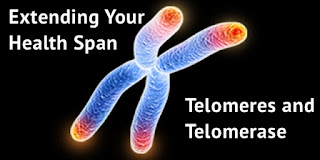Telomeres
What are telomeres?
Let's go back to basic science 101. The nucleus can be found in the middle of our cells, and contain genes — which are arranged in crooked molecules (double-stranded). These molecules that incorporate our genes, when detailed, consisting of chromosomes. If you remember, chromosomes are X-shaped structures, and at the ends of each of those chromosomes are parts of DNA called telomeres.
Telomeres protect genetic information in chromosomes, helping cells to divide properly. They also have secrets on health and longevity (like when we get cancer). Each time our cells divide (as we age) telomeres become shorter, and eventually, they stop dividing and die. The enzyme called telomerase prevents this decrease in certain cell types (including stem cells) by prolonging telomeres. For some time, scientists have thought about the idea that activating telomerase can slow the aging process in cells.
Telomeres and disease.
Many human diseases have been linked to mutations that negatively affect the activity of the enzyme telomerase, thus accelerating the loss of telomere length. These types include some types of anemia, pulmonary fibrosis, and other types of congenital (hereditary) diseases.
New study!
A new research study has found an important step in the telomerase enzyme cycle, called the “catalytic cycle”, which determines the ability of telomerase to produce DNA. The scientific understanding of these mechanisms opens the door for new anti-aging strategies. The hope is that researchers can break the code to enable the body's cells to become immortal. As of today, the age of the cell depends only on the number of times it repeats (repeats itself).
The Molecular “Fountain of Youth”
It is believed that the reverse shrinking of telomeres is the key to longevity by delaying (or even reversing) the aging process.
By its ability to alter the telomerase enzyme process, scientists hope to reverse the shortening of telomeres in the cell, thereby slowing or reversing cellular aging. This can have a dramatic consequence on health and wellness in the elderly. “Telomerase has a built-in braking system to ensure the accurate synthesis of correct telomere DNA replication.
“Finding a way to properly brake the telomerase enzyme has the potential to restore the lost telomere length of adult stem cells and even reverse cellular aging itself,” Chen said. Chen's “brakes” include the encoding of RNA and DNA. Simply put, this is how cells know when to stop translating DNA into proteins (a vital step in ensuring healthy cells function).
The result!
The old adage about many good things applies to a newly developed research project on telomeres. Other than a healthy stem cell process, in the use of telomerase to reduce the loss of telomere length, cancer cells also use the enzyme telomerase — to nourish their destructive growth. Scientists will need to find a balance between promoting healthy cells and increasing the risk of helping cancer cells grow and develop.













Comments